You would feel lost and confused if you were transported back in time to a hospital ward in the 1970’s when the nurses who are now at the end of their careers were students. But you would probably not be as out of your depth as a nurse from that era who suddenly found herself on duty in the present.
The world has changed dramatically over the past few decades, and most of the changes are the result of the growth in knowledge and technology. It has been calculated that towards the beginning of the 1900 knowledge was doubling only about every 100 years, after the World War II it was doubling every 25 years, and it is estimated that knowledge currently doubles on average every 13 months. There have also been noticeable social and cultural changes. Generally, life and human interaction have become far less structured and formal, most likely due to the global human rights movement. These developments have had a considerable effect on patient care, nursing, and nursing practice, as you will see from the recollections below.
Nursing students were part of the nursing staff allocation
In 1970, I was accepted as a student nurse into the only degree program at the time. Although we were university students, we were on government bursaries (a monthly “salary”) and therefore answerable to the hospital authorities.
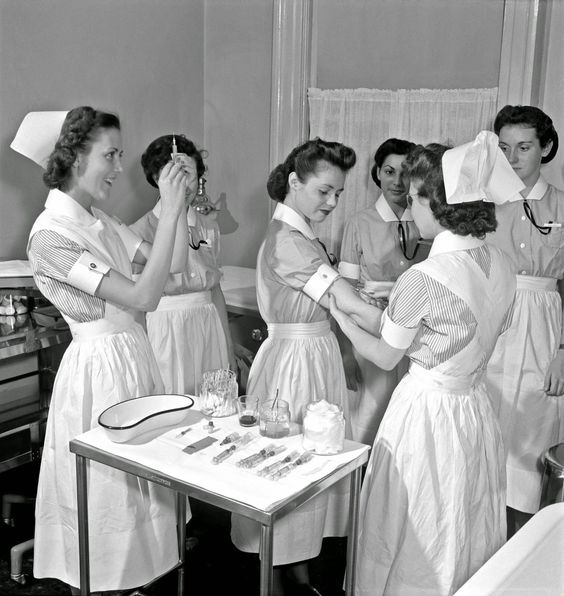
The day after we reported for our course we went to work in our assigned ward for two weeks until lectures started at the University. Students were part of the staffing on the wards, and you had to learn on the go and quickly.
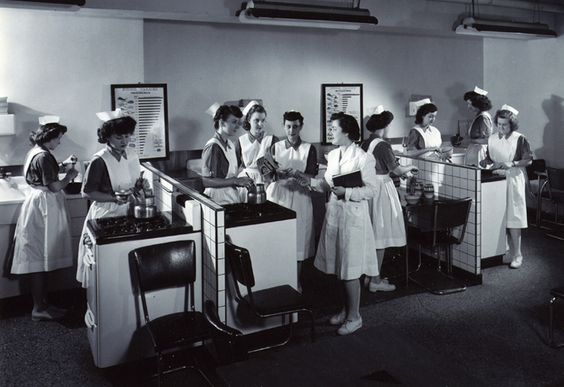
As first year students, we worked five hours per week during term time and a full 45 hours during university holidays except for the regular leave of 30 days a year. Work during term time increased to 20 hours per week in our second and third years (most of it during weekends), and to 40 hours in our fourth year. This while we still had to attend the reasonable number of lectures and study for tests and exams. Registration as a nurse required a certain number of night shift hours, so much of the time during University holidays were spent on night duty.
Discipline
We had to live in the nurses’ residence during our first year. On weekdays, you had to sign in by 19:00 and weekends by 23:00 unless you had obtained a special dispensation from the matron of the hospital. You had to report for duty at least 15 minutes early for the handover report for all the patients on the unit. You were also expected to know the names and conditions of all 30 or more patients.
It was etiquette to allow superiors to go through a door first, and you could often find a group of nursing students forming a “guard of honor” at a doorway
Great respect towards seniors was demanded– the sister-in-charge of the ward, the doctors and especially the matrons were revered. It was etiquette to allow superiors to go through a door first, and you could often find a group of nursing students forming a “guard of honor” at a doorway while the matron was still 20 or more paces away.
Neatness of the nurse herself, as well as the wards, was a priority. Before visiting hours all the bed linen had to be straightened, with perfect hospital corners, the overbed tables had to be in straight line at the bottom of the beds with all the wheels pointing in the same direction. Fortunately, most patients were understanding and endured the trussed up state until the doors were opened for the visitors.
Nurses’ uniforms
We collected our uniforms on induction day – the first of the seven starched white blocks received weekly. There was also a cap in its flat state, a short and a long cape. When we arrived at the nurses’ residence the first order of the day was to learn, under the supervision of the final year students, how to iron the starched block into a wearable dress. The uniform was the double-breasted type, cinched at the waist with a belt. We also had to learn how to fold and pin the caps into what looked like upside-down ice cream tubs and how to fasten them to our hair with clips so that they remained firmly perched in place all day.
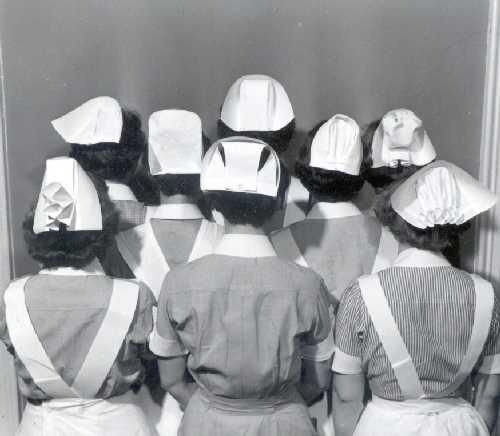
Fortunately, there was a uniform policy change during our second year when we were given a uniform allowance and to buy our own wash-and-wear type uniforms.
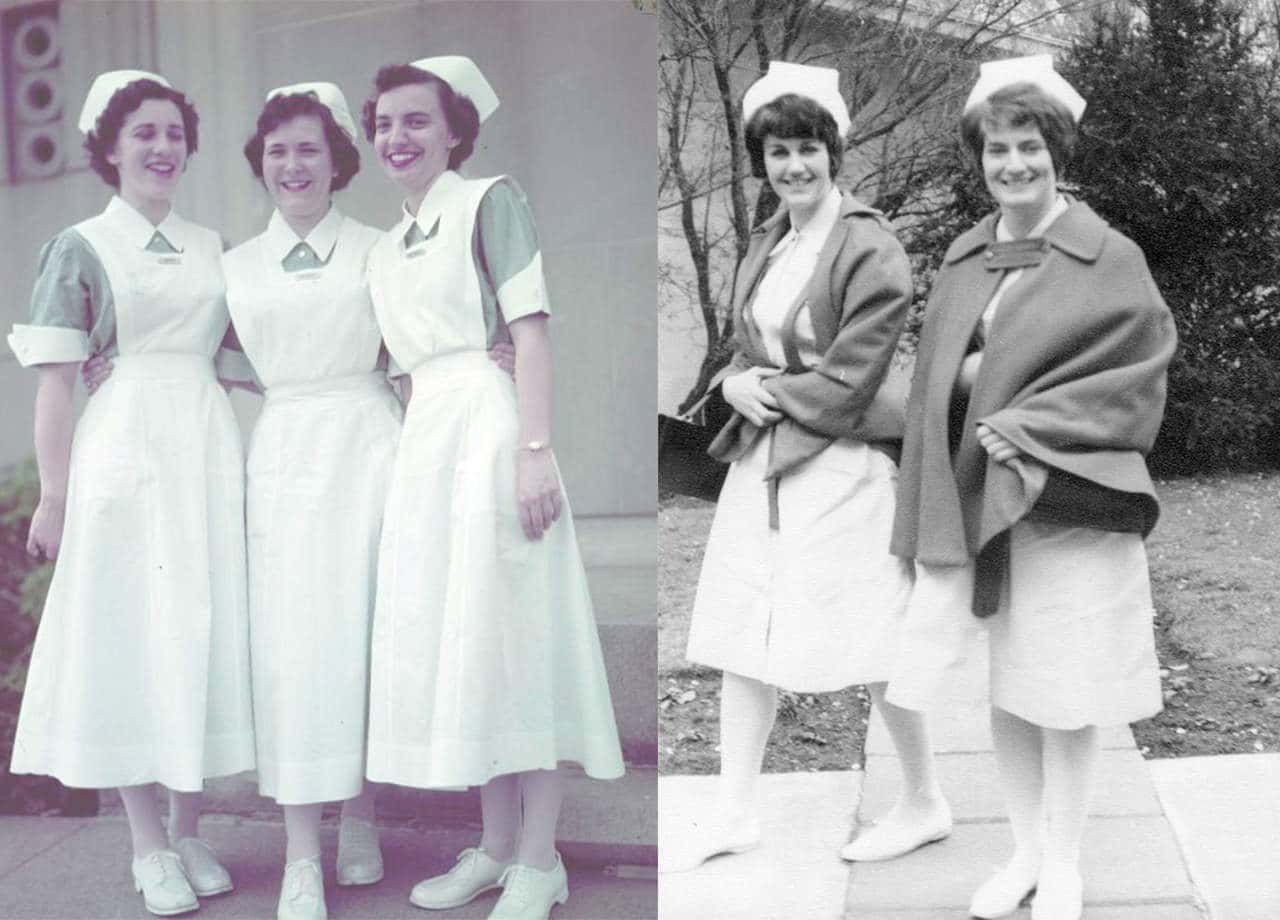
The “mini” was in fashion then, and of course, we all tried to get away with wearing our dresses as short as possible without getting into trouble.
Work allocation
Nursing duties were allocated according to tasks rather than assignment to particular patients. Junior students did the basic nursing duties, such as “beds and backs” or checking all the patients’ vital signs. As you progressed, you do more advanced procedures and tasks. A final year student could at times take charge of a unit if there was no registered nurse (sister) on duty.
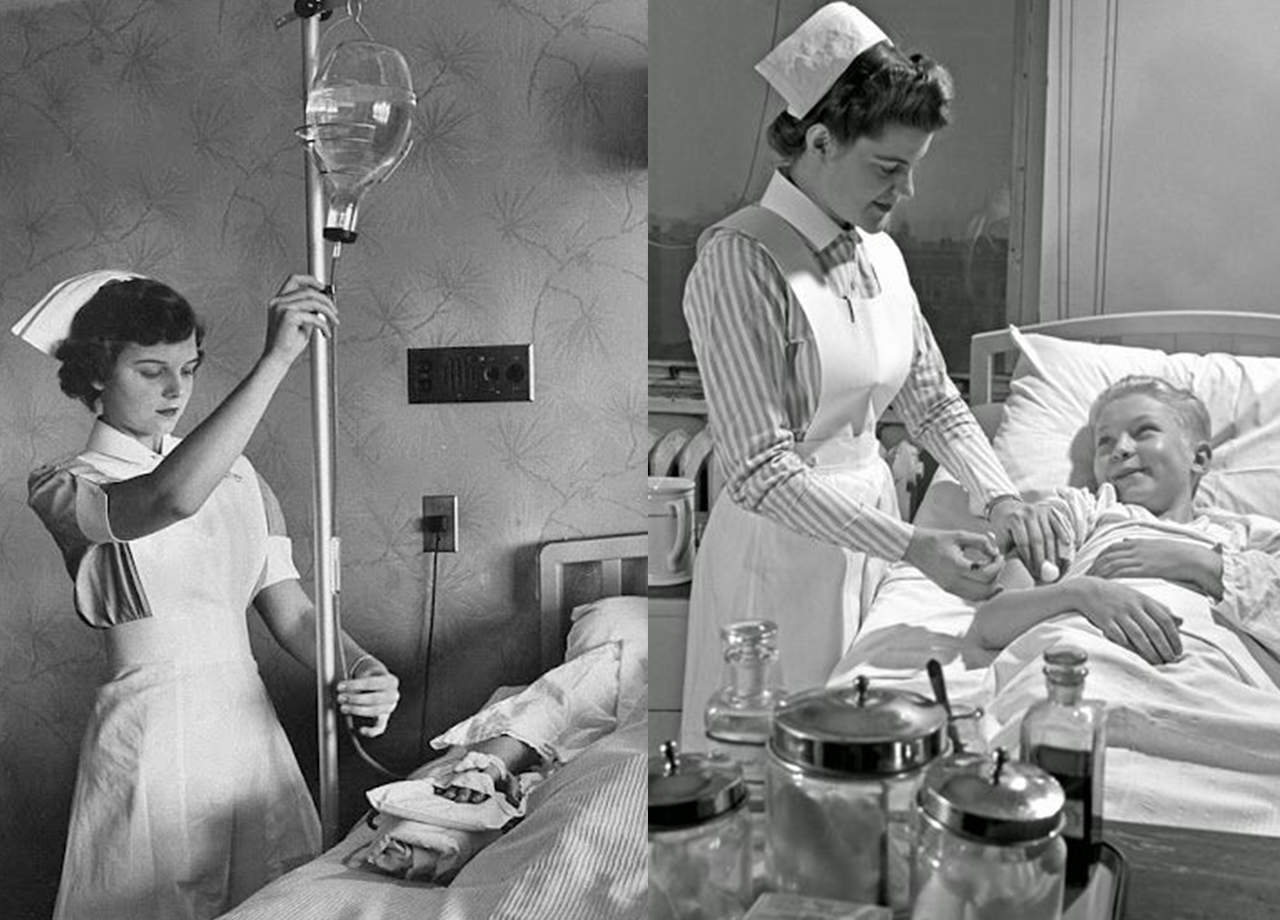
The food was not portion packed, except for special diets. It was delivered in a large trolley and the nurse in charge dished up for each patient. Other nurses would collect the plates, hand it out to the patients and then assist those who needed feeding.
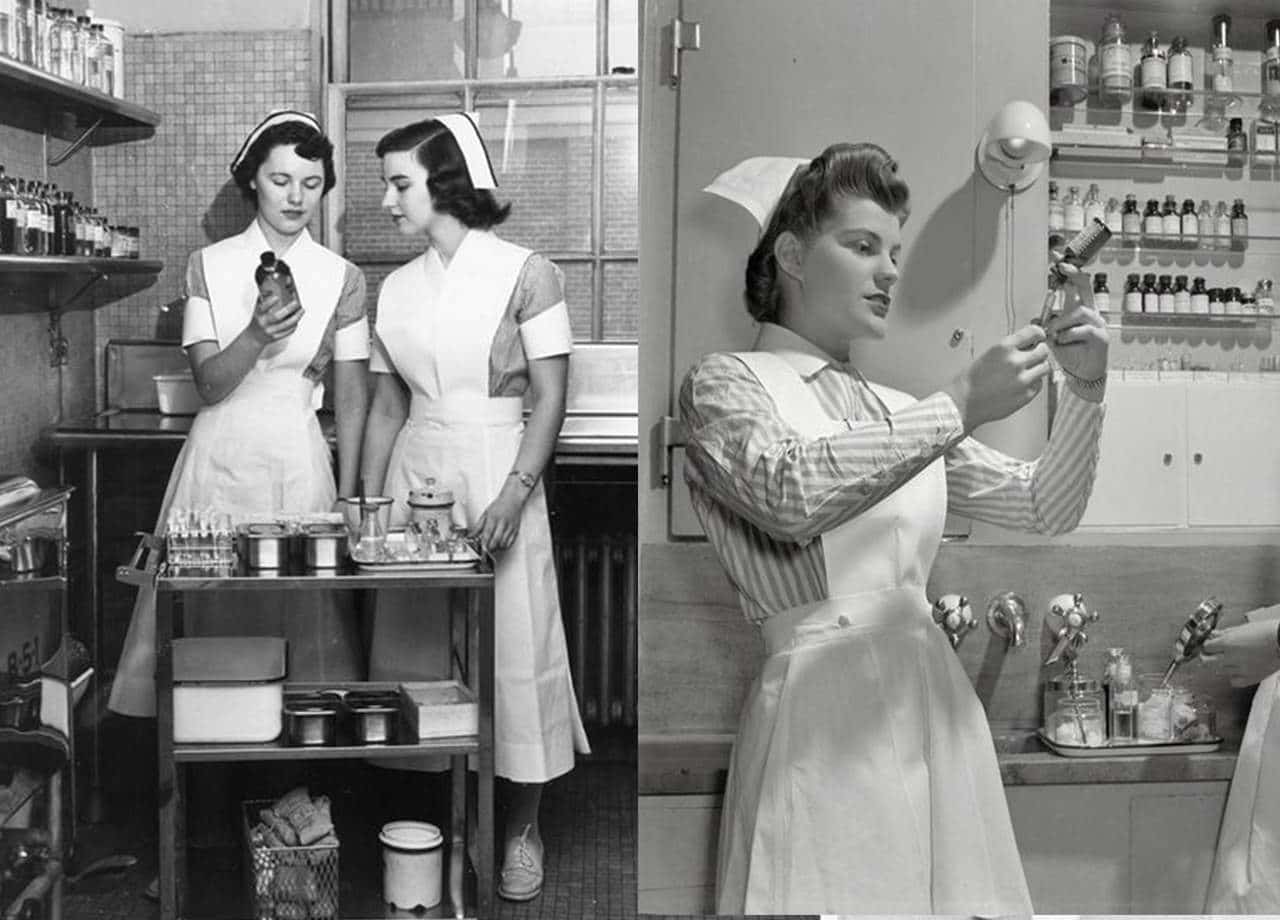
Similarly, patient’s medicines were not dispensed individually by the pharmacy. There was a trolley with the full range of tablets and from here, using a using a card system to which the individual patient’s prescriptions had been transcribed, a senior nurse would hand out the medicines. Considering this system, it was surprising that very few medication errors occurred.
Patient records
There were no computers and no electronic records. Everything was written by hand. The patient’s file was not kept at the bedside but, usually, in a room just beyond the ward office. It contained the admission records, doctor’s notes, prescriptions and diagnostic reports. There was also a vital signs chart on which the nurse responsible for taking the vital signs of all the patients had to chart them in graph format. Recoding vital signs required the use of three-colored pen to reflect the three different shifts. .
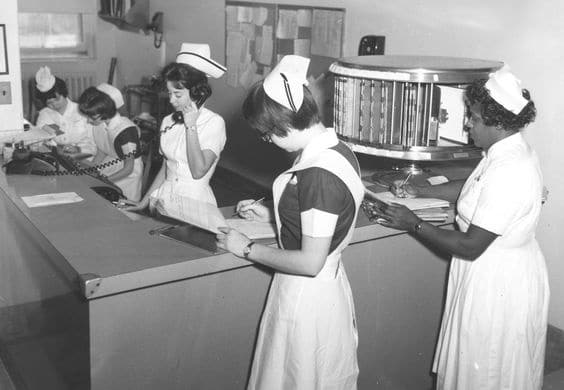
The nursing process and nursing care plan were only introduced widely towards the late 1980’s although this does not mean that there was no planning of nursing care. There was a metal flip folder, with a card for each patient from which the report was handed over to the next shift. Throughout the day any abnormal observations, changes in the patient’s condition and treatment orders would be entered on this card. The nurse in charge would enter specific nursing instructions, conveyed during handing over. Her planning of care was also reflected in the allocation of duties at the start of each shift.
Patient stays
A major shift in hospital care has been the reduction in the length of patient stays due to advances in medicine and technology as well as the increased cost of hospital care. Patients remained in the hospital for at least one night even after minimally invasive surgery. After surgery such as a hysterectomy, patients were on strict bedrest for at least two days and remained in the hospital for five days or, most often, until the sutures were removed. There were no pins and plates for treating fractures and a patient with a fractured femur was placed in traction and remained in the hospital for up to three months. (Consider the mix of the type of patients who most frequently end up with fractured femurs, their immobility while not being ill and young student nurses – made for some interesting times.)
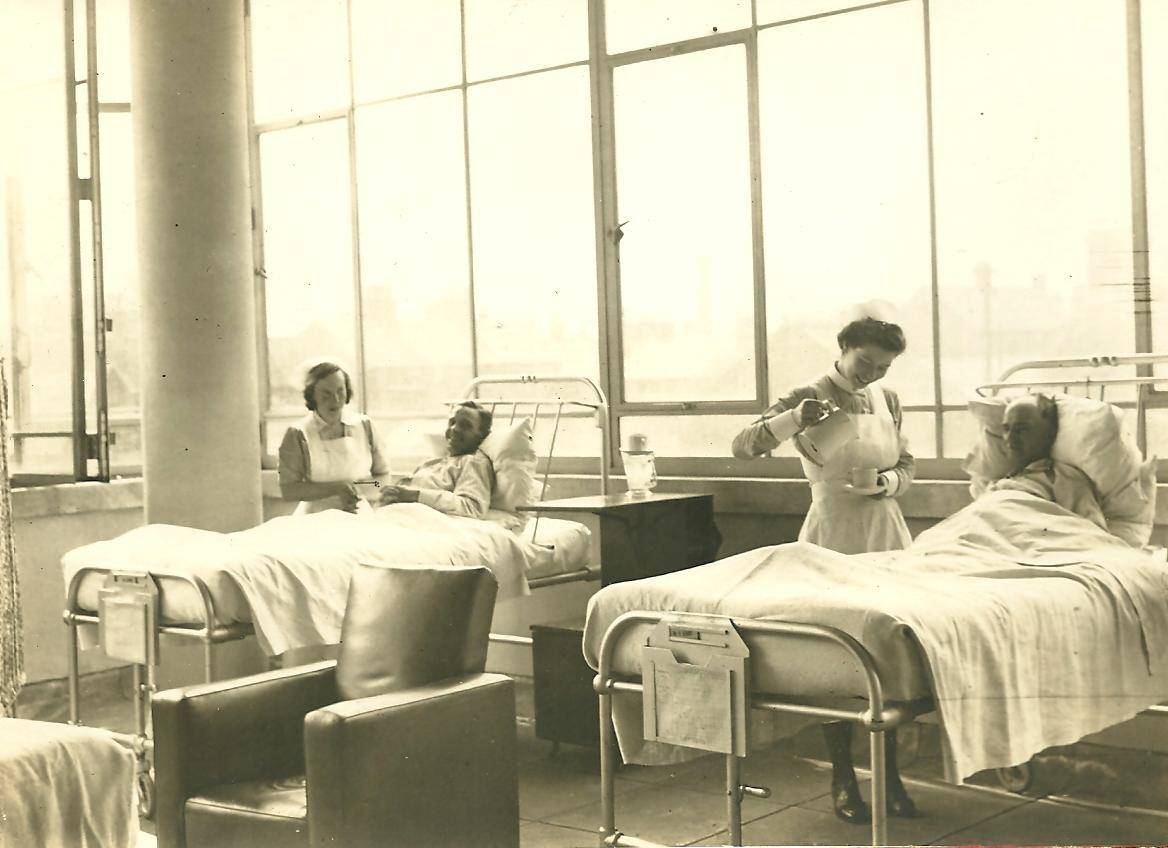
“Beds and backs,” a routine done three times a day, fell into disuse mainly because of early mobilization and shorter patient stays. Usually, in teams of two, nurses went to each patient, in turn, seeing to patient comfort, making general observations and taking action to prevent pressure sores. Bedridden patient’s backs, hips, heels, and elbows were rubbed and creases and crumbs removed from the linen. Pillows were plumped up, water jugs filled, and the general surrounds tidied.
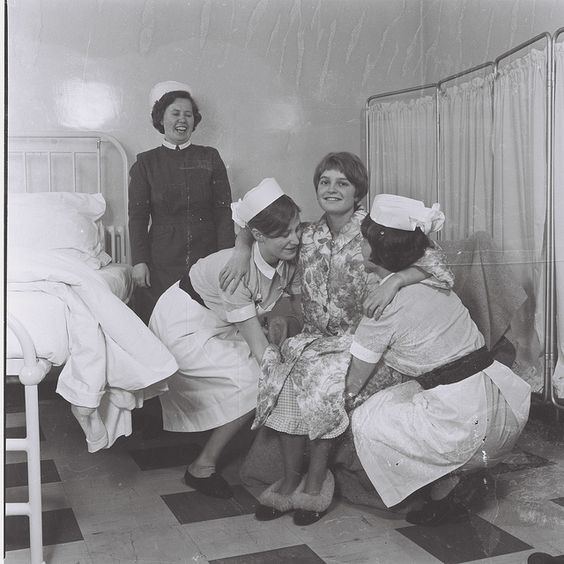
Patient requests would be attended to, and anything unusual in the patient’s condition would be reported to the nurse in charge. There was less focus on infection control then, and you didn’t wash your hands between each patient!
Medical technology
Very little technology was in place to assist in monitoring patients. The temperature was taken with a mercury thermometer, you wore a pin watch for counting the patient’s pulse and respiration, and BP was measured with an aneroid sphygmomanometer. In general wards, each bed did not have an oxygen supply – you wheeled in a portable oxygen cylinder when a patient needed it. Intravenous fluids came in glass bottles and if you needed to control the speed of administration you either counted the drops per minute, or you stuck on a length of tape on which you marked the minutes or hours.
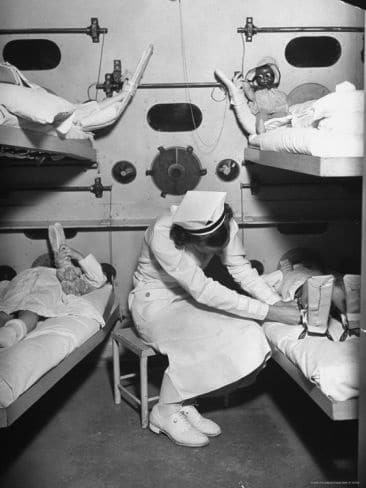
Very few intensive care beds were available in the hospital. Most of the ICU’s were converted side rooms of specialist units with two to four beds. For example, the nephrology unit had a two-bed ICU section for kidney transplant patients. A cardiac monitor, a respirator, and a central venous pressure line were generally the only advanced equipment used in these units. There were no intermediate high care units. Critically ill patients were mostly treated inside rooms on the wards where a form of patient allocation was used when one of the nurses on the staff complement of the unit was allocated to “special” one or two patients.
Other interesting tidbits as shared by Pamela F. Cipriano of American Nurse Today:
- Nurses lived and died by the Kardex, a folded card-stock roadmap to all things for the patient, completed in pencil and continuously crossed out or erased and updated.
- Universal precautions didn’t exist.
- Electrophysiology studies were done at the bedside to discover and treat arrhythmias.
- GI bleeds were managed by inserting tubes with balloons (attached to football helmets) to tamponade varices.
- Warm-water-heated metal bedpans were used for patient comfort.
- Central venous pressure was measured with water manometers.
- Nurses used the second hand of a wristwatch to calculate I.V. drip rates.
- White oxford lace-up shoes were the norm for nurses.
- Only operating-room (OR) staff and physicians wore scrubs.
- Vital signs recording required a three-colored pen to reflect the three different shifts.
- Nurses mixed antibiotics without pharmacist assistance.
- Nurses became proficient in I.V. sticks by practicing on one another.
- Patients were weighed manually.
- Requisitions were completed on typewriters.
- Public health meant well-baby check-ups at the new mother’s home.
- Grandma died at home.
- Patients heading for the OR had their body hair shaved with hand razors.
- Most surgery patients were admitted to the hospital the night before.
- Nursing caps were still popular.
- The Physician’s Desk Reference and the U.S. Pharmacopeia, chained to the desk, were the common drug references.
- Nurses carried trays with cups of pills and med cards.
- Cancer was a death sentence.
- Staff and patients smoked in the hospital.
Nursing yesterday, today and tomorrow
Nursing has changed dramatically over the past few decades and will probably change as much or more over the next forty years, and this is why continuing education has become so important. While developments in society, medicine and technology will change the landscape, it could never replace the essence of nursing – caring for other human beings at a time of need.

I am honored to have all these memories. 1970 graduate of Fairview General Hospital, Cleveland, Ohio
What a trip down memory lane! Although, Nursing Process and Nursing Care Plans were a big part of nursing education in the mid to late 1970’s, in my experience.
The biggest difference between the nursing care story related here from the 1970’s and now, is that the story told here relates to nursing training and practice in Great Britain, not the United States. The photographs provided in the story not only all came from the United States student nursing experience, but from the 30’s, 40’s, 50’s, and a couple from the 60’s. None were contemporary to the 70’s, in my opinion.
This is after having spent the vast majority of my 62 years thoroughly studying nurses’ and student nurses’ uniforms, student nursing experiences, schools, their admission, training and retention requirements, and for a short time, experiencing nurses’ training in the later 70’s myself. We wore pantsuit uniforms in blue and white as students, were required to win our caps following a successful completion of our probationary period, and many of the experiences related here were part of the early 70’s, and had already been supplanted by more technologically advanced practices by the time I got there in 1978 and ’79. A health issue required my leaving training in 1979, and I was unable to return to the medical profession for several years. By 1991, I had done so, entering and graduating in 1993 with high honors from training in a separate profession, focused strictly on Surgical Practice, which I found suited me completely. I enjoyed it immensely, and was quite successful at my profession. However, I never lost my interest in the nursing profession from an academic standpoint, and have never stopped studying and researching its history and progression in all this time. The advent of the Internet has helped immensely, and the more I find to learn, the more I want to learn.
Having read a great deal over the last several years about the set-up or “scheme” of nurses’ education in Great Britain, I immediately recognized the differences in terminology as it applies to their practice.
She describes the individual nurses, i.e., matrons, sisters, etc., the training, i.e., beginning work on the wards prior to any type of classroom education relating to patient care, or even the basic sciences, as well as being part of the staffing plan of nursing care, not being regarded as separate student training; the uniforms, i.e., ironing starched “blocks” of materials into wearable uniforms, and most particularly being furnished with caps from Day One, which was never done in the USA, as caps were something to be “won” following successful completion of a specific period of initial training in nursing schools in the USA; and the general practices of “beds and backs;” straightening everything prior to visiting hours, including rigid “hospital corners” on bed linens, lining up overbed tables at the foot of the bed with even the wheels all facing the same directions; wearing a pin-watch to count pulses, (where nurses in the US all wear wristwatches) and IV drips, etc., and many other details related here.
Also, the description of being University students, while being supported by a government “bursary” or grant fund, which provided all training and associated costs, plus a small stipend for living expense money, as living in the dorms or nurses residences was provided as well. Since that was only required for one year out of four, there were apparently other living arrangements for the following 3 years. This depended on the particular time period involved.
Much of my study has involved a great deal of non-fiction and historically accurate fictionalized stories regarding the young women who took up the profession of nursing and their detailed experiences, whether they became nurses or took on additional training afterwards to become Certified nurse-midwives. This has also involved viewing videos and documentary style plus fictionalized movies from pre-WWII up through and after the War, and studying captioned photographs. Reading interviews done with retired nurses and midwives has also provided a great deal of historically accurate information as well.
Pamela Cipriano’s comments toward the end of the post describe experiences relative to American nursing practice during the 70’s, as far as I can tell. Nothing there sounds relative to the English experience. The photo at the top, showing student nurses being inoculated by more senior students is definitely from the US in the 40’s, as this is one of the first images I found relating to nursing training during WWII, which is a time frame of particular interest to me. Several others below that also are from that time. I have seen most all of these in their original formats, complete with identifying captions.
Agree pictures were not from the 70’s. Much older pics. Just look at the hairdos.
Whole article not my 70’s experience. LVN at that time….RN in 1998.
I was an LVN in a hospital in the 70’s. We worked as teams of two. We had an RN to ask questions to and generally we did bedside nursing and prn pain meds.. It became very scary to me when we were floated to a floor that was not familiar and when total care nursing started.. I’m grateful to have eventually found my niche in a dr. Office for 20 plus years.. working for a wonderful Doctor.. I loved nursing in the 70’s. It was scary as ever later on and I’ll bet a few of us LVNs have ptsd from the experience.
Totally agree. I trained in Canada in the 70s and also worked as a “sister” and a midwifery student in the UK from the 80s to late 90s, and am still in a critical care position today here in Canada. I’ve also worked in a US hospital abroad. Cultural differences were and are huge. As Canadian RNs, we embraced progressing educational goals early, knowing that the role of nursing was expanding exponentially in all directions of health care. The solid foundation of our initial qualification was based on both academic and the practical skills and tools so necessary when caring for complex patients. In the UK, the formality of organizational structure, the expectation of the health care consumer, and the following of precedent was a deterrent to progressive change until the late 90s, when task oriented care took a back seat to the holistic approach, requiring less routine and more critical thinking. Caring effectively as a multi professional team is a universal skill regardless of the systems we work in, be it private or publicly funded. It has been a privilege to share in the lives of patients, families and colleagues down the years.
I attended a diploma program in the US starting in 1968 for three years and could relate to a lot what is said in this article. We received generic caps from day one with a blue stripe added in our second year and and a black stripe in third year. At graduation this black stripe was removed and placed on the cap of our school.
We used our second hand watches to count pulses and to calculate IV rates. Our nursing instructor was a stickler for a clean and unencumbered patient area, so yes, our beds were made with neatly mitered corners and tables were placed at the end of the bed when not in use.
We started IV’s on each other and inoculated each other after being instructed.
A lot of what you refer to as from the 40’s did indeed happen in the 70’s when I completed my program.
Hi! Thanks for your input. One small question–the minor detail about a patient’s vitals being handwritten into a report with a three-colored pen: was that an English phenomenon or were the three-color-pens (for 3 shifts) used stateside as well? Thanks much.
I was trained in 1971 during that period the student Nurses also considered as part of the staff and answerable to the Hospital Organizational. we practice Block system and during 2nd year I was put on night duty. There was no clinical supervisorbutthe ward staff is responsible to look after and take care of us.
Yes Yesterday was a Memory . tomorrow is mystery but today is reality.
so we have to update and advance our Professional knowledge to keep abreast with today’s demand and client’s expectations. We nurse always keep up with life long Learning in tanda with our Nursing Etiqque.
I was trained 1974 to 1976. I went to a JUCO or jr college for my ADN program. We were pale yellow striped uniforms..we had a pants suit and a dress. We wore the white lace up shoes and white Hose. If your finger tips were longer than your skirt..u went home to change. We were assigned several pts to work on and learn about..NG tubes were red rubber connected to GOMCO suction machines and you emptied the bottle every shift in tha toilet after measuring it, of course. Length of stay averaged a week..IV bags were being used but had a bottle once in awhile. Alot of IM injections for pain..Demerol and Phenergan or Vistaril we drew up in the same syringe. Nembutol for sleep at bedtime..or Dalmane. And Darvon or Tylenol #3 for pain pills..and loved every minute of the changing world of medicine. Ended up loving Cardiac..TPA given IV and watching the “tombstone T,s ” on the EKG disappear! I am proud I was a nurse in the last 43 yrs and learned so much about the human body AND soul. What a wonderful profession!!!
Just wanted to point out that the student nurses were wearing capes, not coats and they were part of the students uniform.
I was at the University of South Carolina from 1963 til 1965 and ours was the first class who did not have the cape. Instead we were instructed to buy a truly UGLY gabardine navy blue coat with the school initials on the collar. I don’t recall ever wearing it.
Our uniform was yellow with sewn on collar and white cuffs. The cuffs and front of the uniform had pin on buttons that had to be removed for laundering. I left in 1965 to get married and followed my husband in his army assignment.
I returned in 1973. Then it was a 1 piece dress with buttons. But nonetheless it was a dress. A cap was optional and if we wanted one we could go to a uniform store and buy one. If we wanted a pin, we could go to the student union and buy one there too. When I graduated it was with the rest of the University grads and we had no capping or Nightingale pinning ceremony. In the hospital after graduation it was 2 or more years before pants were allowed still white though. And it was another 20 years before scrubs-still of specified colors were introduced.
Hello from Australia where I started hospital training in 1961. We had to buy our tailor made uniforms and they were starched I DO recall. We also had the “guard of honor’ in door ways. We too mixed our own antibiotics and took IV samples for pathology but did not insert IV lines. Yes we regulated them with the calculated drip/minute system. We worked 40 hours per weeks with education mostly in our own time and study as well but we enjoyed 6 weeks holiday. I worked on &n off for about ten years and retired. After my husband died I went to university to gain my bachelors degree and started again at 67yrs and worked 18 months in aged care till I retired again. Restless at 72n years I began again in aged care. They needed wisdom ^ experience & I could do this rewarding work. I agree the main changes are knowledge and technology. How fortunate science had discovered so much more to assist us coping with our heath and care. Nursing is a dedicated pleasure. Enjoy!
I entered nursing school in 1961. I remember that the doctors were Kings, and all nurses and students had to shelve the charts we were working on if an MD walked in, moving away from the desk to give the docs unhindered access.
I graduated from a three year diploma program then onto a college degree then MSN . I am proud of my nursing education.
some photos appear to be earlier i.e. 1950-60. I could identify with them easily as I completed “training “i as it was called in1957. We provided for those committed to our care with respect and competence. Not an easy task but the most rewarding. My basic education was a diploma from a nursing school ranking third in the state of Pennsylvania at the time.
I love the trip down memory lane, bringing back good memories back. This article took me right back to the patient’s bedside.
Good reading.
Kids today could never handle the work load then. I worked in pediatrics for 47 years and when I started I had one side of a hall which was 10/12 patients and we did all our own cpt and postural drainage. If we were lucky there were 2 lpns and 1nursing assistant and the nas didn’t do apicals or bps. The rn did most of the meds and all ivs a d if we were t lucky we had 1lpn I rn and 2. Nas.
I trained 1965-1968 for state registration. I also am certified midwife, training in 1970.
The biggest difference to me other than obviously more modern techniques is the attitude to nurses then and now. In my home town of Liverpool we travelled to work in our uniforms and were hardly ever charged for our fare on the buses. If we were late and had to get a taxi we also were rarely charged for the ride. People loved and respected nurses then, so much more than today, now there are police stationed in some hospitals to deal with attacks on staff. This was unheard of in my day. The other big difference is the appearance of todays nurses, when my husband was in hospital recently a rather untidy person with holes in her stockings and worn down shoes stated she was the Matron. I was shocked to put it mildly. We all, from student nurses up to Matron had to be immaculately turned out. We recorded all information for each patient in the kardex and every nurse knew the names and diagnosis and treatment of every patient, unlike today. If you ring to enquire about a particular patient now, very often the person answering has no idea who the person is, My hospital was staffed by student nurses and senior nurses only. We worked full time on the ward after an initial 2 months in preliminary training school, and learned more or less everything from more senior nurses. I do think that nurses had much more time to actually care for the patients then and we worked very hard, some wards had up to 50 patients. Not saying that they don’t now, but that caring attitude and respect for the patient sometimes seems to be absent Sorry that is just my opinion.
I loved my job, and miss those days very much. It is a wonderful profession but I think the methods of training now fall short.
We have advanced so much in our practice and education. Every nurse deserves an applause today for their efforts on the front line. What really surpises me is that they are still here today and they do their job. It’s more than a job it’s what we do. Its who we are. All nurses go above and beyond today as they did yesterday. If it wasnt for our nurses in the 50’s, 60’s ,… we would not be who we are today.
I trained during the middle 70’s. Remember these times so well. Nursing has changed in theory, but not in compassion and caring. So proud to be a nursr
I trained during the middle 70’s. Remember these times so well. Nursing has changed in theory, but not in compassion and caring. So proud to be a nurse
Another Aussie nurse here ..trained 1963 to 67 ..loved those 4 years the nurses these days just dont know what they missed with hospital training ..great time and met many great friends ..but i dont remember having to pay for my uniforms only shoes and maybe our capes .
You are absolutely right.
Great article. I trained from 1966 to 1969. Best time of my life, looking back now. As a diploma Grad. I could immediately function as a RN on Med-Surg floor. Years later went on for additional education and utilized my nursing education in industry. Advance education is wonderful but can not replace the hospital experience Diploma Nurses received
As a graduate of Mt Sinai Hospital School of Nursing in 1967, I have never been so proud. Yes, that Mt Sinai in New York City, of corona virus fame. Thank you Gov. Cuomo.
I have always believed there was never any better education. And we were told to treat our patients as “guests”. Never to be forgotten.
Mitral valve replacement was in its infancy, and working in that unit was amazing. This article brings a smile. And covers present day sadness around nurse to nurse bullying and intimidation.
But there is always the patient who mkes everything right.
Adair Fingerhut RN,BA
I graduated from an ADN program in 1969. So many things described in the article I remember, I went on to complete my BSN. I worked in many areas – CCU, Med- Surg,- Surgical Oncology etc. Have always been immensly proud of my profession.
Hi Shari, were nurses allowed to work based on graduating and passing boards or did they need to be licensed by the state in 1970?
Anna – I’m not quite sure how to answer your question, because it’s actually a combination of all the things you mentioned. But, I’ll give it my best shot!
Graduating from an accredited school of nursing, then passing the State Boards for the State in which you live at the time, which then confers on you your “RN” and State license to practice as an RN.
I know that the exam for State Boards USED TO BE a rather lengthy process, with paper and pencil, which was offered only a couple of times a year following graduations, after which you had to wait for all the exams to be graded, which could take several weeks. Then, you were notified via the mails whether or not you passed, and could then add RN after your name, and fully practice nursing.
Before that, between Graduation and that notification, you were allowed to practice temporarily as a GN, or Graduate Nurse, as long as you had taken your State Boards, and were waiting for the results to come back.
I’m not sure exactly what happened if you didn’t pass that first time, and had to retake the exam, which wouldn’t be offered again for some time, regarding whether or not you were allowed to continue working as a GN. I kind of think not, but I’m sure other nurses here would be able to answer that particular circumstance.
My daughter got her BSN* a few years ago, in an accelerated University Nursing School program, which accepts students who already have completed a Bachelor’s Degree (4 years education in most any college/university, leading to a degree) in most other disciplines, as long as the basic sciences were covered. They then took only the focused nursing education classes in about 18 months, to graduate with their BSN degree (*Bachelor of Science in Nursing.) When she graduated from the University, the NCLEX exams which are the State Board Exams to get their RN, had already been taken at the end of their program, while still students.
Since they have long been converted from paper and pencil to computer based testing, there is not such an extended period of time between testing periods, or between testing and a 4 to 6 weeks wait time to get your results. The exam results (I think) are immediately sent to the school (or the program) revealing each students results, but not revealed to the students until they actually follow through to graduate.
(This may be partially incorrect, since it’s been a few years since she graduated, and it seems she was job hunting before she graduated, of course.) They may give them their results before they actually graduate, which would make job hunting easier, if they could do it as State registered RNs.
The RN licenses are governed on a State level. Some states offer what’s called “Reciprocity” with other states. This means their State Licensing Board recognizes as valid the license from another State, and those nurses can be recognized automatically as RNs without having to take another board exam from that other state in order to be licensed to work in that State. Some other states don’t offer reciprocity with any other states, and I believe there are a few/some who recognize all other states. Which ones recognize which others can be verified on line if anyone is interested.
Hope this is #1 – accurate, as I’m sure of the older information as I have verified through constant research and reading of vintage sources. The more contemporary information has come primarily from my daughter’s recent experiences, and conversations I have had with nursing students and recent graduates as I worked with many of them throughout my own career as a Certified Surgical Technologist, over a period of 2 years of education, followed by 15+ years as a practicing CST in several different areas, such as a Traveling Surgical Tech, a PRN agency Tech, and a full time tech in several hospitals and ambulatory surgical centers. Plus, my experiences I gained as an student Practical Nurse (LPN)
in the late 1970’s.
And, #2 of course, that you found it interesting and informative. Thank you for asking me!
Loved your description of your nsg experiences,that includes college n as a graduate.
When I was 14,I worked as a volunteer in a city hospital 8 hrs,5 days a week for 2 summers n week ends for 4 yrs.
As a volunteer my favorite place to work was in the ER
My experiences included working working as a nses aid,an internship in Boston n worked as an LPN the last two years at Columbia Presbyterian MC-Babies Hospital while I completed my senior year in college.
I’ve worked in N.Y,N.M and N.J.
Did home visits on farms, traveled with a team of nses throughout NM administering the swine fu vaccine.
I’ve had the oppotunity to work as a school nse,worked in a dr’s .office,private duty, parish nse,phn nsg sup n retired as a clinical instructor in simulation lab teaching @ a college.
My nsg career lasted 52 yrs.
When I retired I became a chaplain n my dream was to be a chaplain for nses
My career has been bigger than I could have ever imagined n loved it.
My dream was to be a nse was to ” give shots n listen to children”..n I did.
I’m blessed.
Bobbie
I went to a BSN university program at the University of Texas from 1975-1977 and this article is not accurate. The pictures and descriptions of the nursing work are from the 1950s and maybe 1960s. I lived with my parents, some students who were married owned their own homes. I was not paid and never used as floor staff. The beds were more like the modern ones we have today and we even had IVAC IV pumps. My uniform was a white, polyester pant suit and we did not wear caps. This is a misleading article and I resent its inaccuracies.
Linda I graduated in 1971. The pictures in the article were so familiar to me. I only wore dresses, white hose and oxfords. The beds were with a dark headboard…but the student nurse we wore pinafore uniforms. I don’t remember an IV pump. I never went without my cap. I was not used as a staff while a student and was not paid. I loved the article and it brought back great memories..
Thank you for sharing your memories. It’s lovely to hear that the article brought back fond recollections. Is there a particular memory from your nursing days that stands out as your favorite?
life individual experience may very
Also, as a student and after I graduated we used nursing process and wrote care plans. That did not start in the 1980s in the US.
It was wonderful to read all the stories I graduated in 1982 in the USA 2 years prior I graduated and trained in Ireland.Spent most of my nursing career in ER and ICU. Loved it all
Its sad that the corporations have taken over the hospitals its not the same.Will be retiring very soon Thank God but I will miss it.
I was glad to discover this website and I’ve enjoyed reading the posts. I started nursing school in 1973 at the University of Bridgeport in CT. Looking back, I wish I had entered the BSN but the ADN program shared same nursing courses and clinic time. I took courses over the summer in between the two years and over winter break. It was intense yet rewarding and I loved school.
We went to the local and not so local hospitals for clinic. The dress code included a white dress (no pants) uniform not above the knee, cap, white pantyhose, white “clinic” shoes, watch and only gold stud earrings. Only a plain wedding band if you were married. No fingernail polish and very little lipstick. Your name tag on display was required. Patient’s gown were called Johnny Coats. The IV fluids were in a glass bottle, not a plastic bag. There wasn’t too many items that were disposable. The bed pans and emesis basins had to go to the “dirty utility” room to be picked up and autoclaved.
I started my first job a month after graduation and it was nothing like nursing school. I was assigned to follow an RN until she felt I was able to be on my own. There were new medication names, new procedures, new noises, doctors on the floor seeing patients and barking out orders.
We took vital signs manually. There were no infusion pumps, IV drips were calculated. The Kardex at the front desk was being changed often. Back in the early 70’s, people were admitted the day before a GI Series, endoscopies and colonoscopies. The nurses did their preps.
There were only 8 hour shifts: 7-3, 3-11 and11-7. The charge nurses on each shift made room to room “rounds.”
Patients smoked in their room and the nurses smoked in their lounge. The bedpans were metal, heavy and cold. We inserted foley catheters and NG tubes.
We were required to rotate to “nights” until we were employed for 5 years. I absolutely hated night shift. I could not sleep a wink during the day!
By 1976 we could wear pants but we still had to wear our caps. We could take a “verbal order” on the phone from a physician.
I was glad I was put on a Medical floor as a GN because I learned a lot. Eventually, I worked
in L & D, the NICU and Oncology.
I am proud to say I am an RN or I should say, RN (Ret)
I remember those days . I graduated from Albert Einstein Medical center School of Nursing class of 1971.in Philadelphia Pa
Ahh….all the memories.
I graduated nursing school in 1971, and retired in 2015.
The 70’s were a great time to be a nurse – more time to spend with our (few) patients, keeping up the Kardex instead of dumb nursing care plans and soooo much less aggravation from nursing admin! I’d never go into nursing nowadays.
Amazing not one comment about men in Nursing in this article
I graduated from a 3 year diploma program in 1972 and was one of only 6 males to graduate and become an RN
Kudos to you! I think the increasing rates of men in nursing brought good things like increased salaries and respect. Thanks for being in the vanguard!!
Not sorry one bit to leave the profession as an RN. After 28 years, 22 of which were in the ICU, enough was enough.
Having so many “highly educated” BSN nurses around, you’d think they’d stick up for themselves – demand lunch breaks, turn down unsafe assignments, demand staffing ratios, OPPOSE Nursing Administration’s ever increasing idiotic demands. Nope, hasn’t happened and it never will. So sorry, but your still just a warm body, blindly following orders and that’s all future nurses will ever be.
If nurses followed the same “fellow hood” of other professions like police or firefighters, nursing would be a totally different profession.
Battle cry to all nurses – Do we work for a hospital or do they work FOR US?! Sadly, the later is nonexistent.
l trained at the Prince Charles Hospital in the early 1980’s. Things were much the same. The cap had been taken away from the uniform the year before l started. Backs and bums where still in force plus enema’s and apperients at night, do the finger check. That was in the geriatric wards which were quite dehumanizing. We had 2 males in our intake one of which didnt like me at all, l accidently dumped a hot pizza in his lap. Oh well. Australia mimicked the UK quite closely. l remember we implimented the nursing care plan in the early 1980s. We had the starchy uniforms, light blue with white collars. (Enrolled Nurse). The RNs wore white, some still wore their veils. No nurses wore the caps though. l stayed at the nurses quarters during my training. Males were on the top floor, doctors included. We had to wear leather brown lace up shoes which made a racket on the lino floors. Loved my fob watch. We also had a red jumper or cape. l loved the capes. l have very fond memories of nursing and wasn’t happy when l left to have my first child. lve missed it ever since.
Trained in early 70. RN 1975. Still working. Age 70 now. Will retire soon
Did Nancy Swanson go through this program in 1970′ some time?
Many of the posts have hit things that reminded me of my training. I graduated from an LPN school in 1971. The program was affiliated with the city schools that it was in. I moved to Ravenna OH which is only 6 miles from Kent State U that had a BSN program. I was lucky that I had taken almost three years of college courses before deciding to be a nurse. When I went to KSU to discuss admission to the BSN program they told me to take 3 chemistry and 5 biology courses and come back when I was done with them. Obviously I had no science courses as my original major was music.
I remember taking my LPN boards in what was a barn on the OH State Fair property. We had to have a picture of ourselves on our table. If we expected to need kleenex, cough tablets, etc during the exam they had to be on our table. The tables were for only 2 people. If you had to use the restroom a monitor went with you. It was very intense. And the wait for the results was long.
KSU did not like students that were already nurses. Mostly because we already had ideas about how to practice nursing. My peds instructor told me that she was “forced to give me an A” My next instructor told me she would be glad to sign for me when I went for a doctorate. How do you handle such desperate opinions. So I bolted to Youngstown State U that had an accredited ADN program.
Finished my ADN in 1982. I was not as intimidated taking the board exams because I had already taken one set and knew all of the stressors involved/ Plus the state had upgraded us to the convention space in a hotel. The wait wasn’t as long to get the results, but the test was still pen and paper. The questions were scenario based so you got a story and then questions that applied to many aspects of the individual patient. I remember older nurse telling me that the boards were divided into sections like Obstetrics, Pediatrics, Medical, Surgical and that if you failed one section you could retake only that section.
I worked for the same hospital for 36 years. My favorite was the ER where I worked or 15 years. Also spent 10 years giving conscious sedation in Endoscopy. Retired at 30 years and went back and worked 6 years (only 2 days a week) as a visiting nurse,
If you have read this far thank you for reading. Nursing was the best thing that ever happened to me.
Hi Claudia, Thank you for sharing your incredible nursing journey – what a ride from LPN in ’71 right through to ER and visiting nurse gigs! It’s so cool to hear about your experiences, especially those early days of LPN boards in a barn and the evolution all the way to hotel conference rooms for the ADN exams. That’s some serious change!
It must have been quite something, balancing the old-school ways with the new approaches, and dealing with those diverse opinions in your BSN program. Then landing in the ER and Endoscopy – those are intense areas to work in. And even after retiring, you jumped back in! That’s dedication.
Your story is super inspiring, showing just how dynamic and rewarding a career in nursing can be. If you’ve got any nuggets of wisdom for the newbies in the field or thoughts on how nursing’s changed over the years, I’d love to hear them.
Thanks again for taking the time to share. It’s stories like yours that really show the heart and soul of nursing.